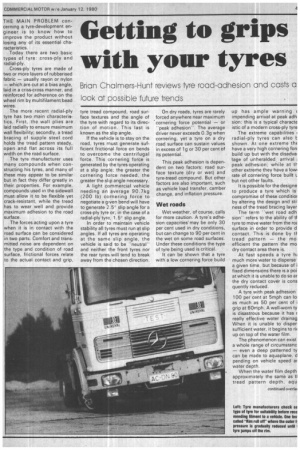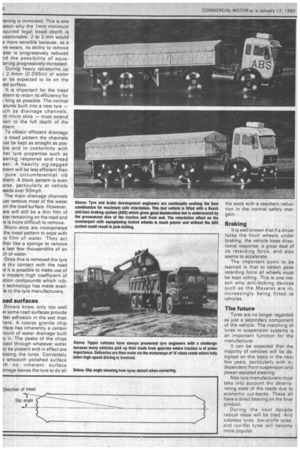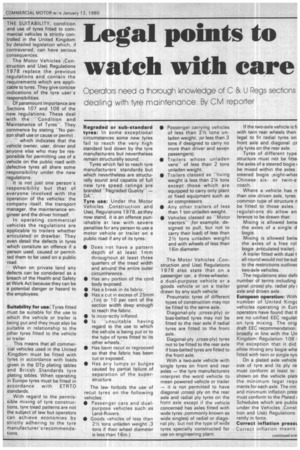Getting to grips with your tyres
Page 45

Page 46

Page 47

If you've noticed an error in this article please click here to report it so we can fix it.
tyre tread compound, road surface textures and the angle of the tyre with regard to its direction of motion. This last is known as the slip angle.
If the vehicle is to stay on the road, tyres must generate sufficient frictional force on bends to overcome the centrifugal force. This cornering force is generated by the tyres operating at a slip angle; the greater the cornering force needed, the greater the slip angle necessary.
A light commercial vehicle needing an average 90.7kg (200 lb) cornering force to negotiate a given bend will have to generate 2.5 slip angle for a cross-ply tyre or, in the case of a radial-ply tyre, 1.5' slip angle.
In order to maintain vehicle stability all tyres must run at slip angles. If all tyres are operating at the same slip angle, the vehicle is said to be -neutral" and neither the front tyres nor the rear tyres will tend to break away from the chosen direction. On dry roads, tyres are rarely forced anywhere near maximum cornering force potential — or "peak adhesion-. The average driver never exceeds 0.3g when cornering, yet a tyre on a dry road surface can sustain values in excess of 19 or 30 per cent of its potential.
This peak adhesion is dependent on two factors: road surface texture (dry or wet) and tyre-tread compound. But other factors are also important, such as vehicle load transfer, camber change, and inflation pressure.
Wet roads
Wet weather, of course, calls for more caution. A tyre's adhesion capacities may be only 30 per cent used in dry conditions, but can change to 90 per cent in the wet on some road surfaces. Under these conditions the type of tyre being used is critical.
It can be shown that a tyre with a low cornering force build up has ample warning ( impending arrival at peak adh sion: this is a typical characte istic of a modern cross-ply tyre
The extreme capabilities 1 radial-ply tyres can also t shown. At one extreme thE have a very high cornering for( build up but with the disadva tage of unheralded arrival i peak adhesion; while at tlether extreme they have a low' rate of cornering force built L but not other faults.
It is possible for the designe to produce a tyre which is compromise of these conditior by altering the design and sti' ness of the tread bracing layer
The term "wet road aidh sion'' refers to the ability of tf tyre to move water from the roz surface in order to provide d contact. This is done by tf tread pattern — the mo, efficient the pattern the mo dry contact area there is.
At fast speeds a tyre much more water to disperse a given time, but because of i fixed dimensions there is a poi at which it is unable to do so ar the dry contact cover is cons quentiy reduced.
A tyre with peak adhesion 100 per cent at 5mph can loi as much as 50 per cent of i grip at 60mph. A well-worn ty is disastrous because it has r really effective water drainag When it is unable to disper 'sufficient water, it begins to ric up on top of the water film.
The phenomenon can exist a whole range of circumstanc — even a deep patterned ty can be made to aquaplane, d pending on vehicle speed ar water depth.
When the water film depth approximately the same as ti tread pattern depth, aqu laning is imminent. This is one )ason why the 1mm minimum )guired legal tread depth is uestionable; 2 to 3 mm would e more sensible because, as a (re wears, its ability to remove ater is progressively reduced rid the possibility of aqualaning progressively increased.
During heavy rainstorms up
2.4mm (0.095in) of water 3 n be expected to lie on the iad surface.
It is important for the tread attern to retain its efficiency for ; long as possible. The normal atures built into a new tyre — Jch as drainage channels, id micro slots — must extend )wn to the full depth of the attern.
To obtain efficient drainage a tread pattern the channels ust be kept as straight as posble and in conformity with her tyre properties such as eering response and tread ear. A heavily zig-zagged mem will be less efficient than pure circumferential rib rttern. A block pattern is even orse, particularly at vehicle ieeds over 50mph.
The main drainage channels ust remove most of the water )m the road surface. However, ere will still be a thin film of ater remaining on the road and is is more difficult to remove.. Micro slots are incorporated the tread pattern to cope with is film of water. They act ther like a sponge to remove e last few thousandths of an 7.hi of water.
Once this is removed the tyre is dry contact with the road id it is possible to make use of e modern high coefficient of ction compounds which rub1technology has made availle to the tyre manufacturers.
Dad surfaces Drivers know only too well at some road surfaces provide tter adhesion in the wet than hers. A coarse granite chip rface has inherently a certain tount of water drainage built -0 it. The peaks of the chips aject through whatever water ay be present and in effect are sisting the tyres. Conversely a sm000th polished surface th no inherent surface 3 inage leaves the tyre to do all
the work with a resultant reduction in the normal safety margain.
Braking
It is well known that if a driver locks the front wheels under braking, the vehicle loses directional response, a great deal of its retarding force, and also seems to accelerate.
The important point to be learned is that to obtain peak retarding force all wheels must be kept rolling. This is one reason why anti-locking devices such as the Maxaret are inincreasingly being fitted to vehicles.
The future
Tyres are no longer regarded as just a secondary component of the vehicle. The matching of tyres to suspension systems is an important function for the manufacturer.
It can be expected that the majority of vehicles will be designed on this basis in the next few years, particularly with independent front suspension and power-assisted steering.
Also tyre manufacturers must take into account the deteriorating state of the roads due to economic cut-backs. These all have a direct bearing on the final product.
During the next decade radical ideas will be tried. And tubeless tyres. low-profle tyres, and run-flat tyres will become more popular. THE SUITABILITY, condition and use of tyres fitted to com mercial vehicles is strictly controlled in the United Kingdom by detailed legislation which, if contravened, can have serious consequences.
The Motor Vehicles (Construction and Use) Regulations 1978 replace the previous regulations and contain the requirements which are appli cable to tyres. They give concise indications of the tyre user's responsibilities.
Of paramount importance are Sections 107 and 108 of the new regulations. These deal with the "Condition and Maintenance of Tyres". They commence by stating "No person shall use or cause or permit.
which indicates that the vehicle owner, user, driver and anyone else who may be res ponsible for permitting use of a vehicle on the public road with defective tyres all share some responsibility under the new regulations.
It is not just one person's responsibility but that of everyone involved with the operation of the vehicles: the company itself, the transport manager, the maintenance engineer and the driver himself.
In operating commercial vehicles the regulations are applicable to trailers whether articulated or drawbar. They even detail the defects in tyres which consitute an offence if a person used, caused or permitted them to be used on a public road.
When on private land any defects can be considered as a breach of the Health and Safety at Work Act because they can be a potential danger or hazard to the employees.
Suitability for uses Tyres fitted must be suitable for the use to which the vehicle or trailer is being put and they must also be suitable in relationship to the other tyres fitted to the vehicle or trailer.
This means that all commercial vehicles used in the United Kingdom must be fitted with tyres in accordance with loads given in the DTp plating tables and British Standards tyre plating tables. When operating in Europe tyres must be fitted in accordance with ETRTO standards.
With regard to the permissible mixing of tyre constructions, tyre tread patterns are not the subject of law but operators can achieve economies by strictly adhering to the tyre manufacturer's recommendations.












































































































